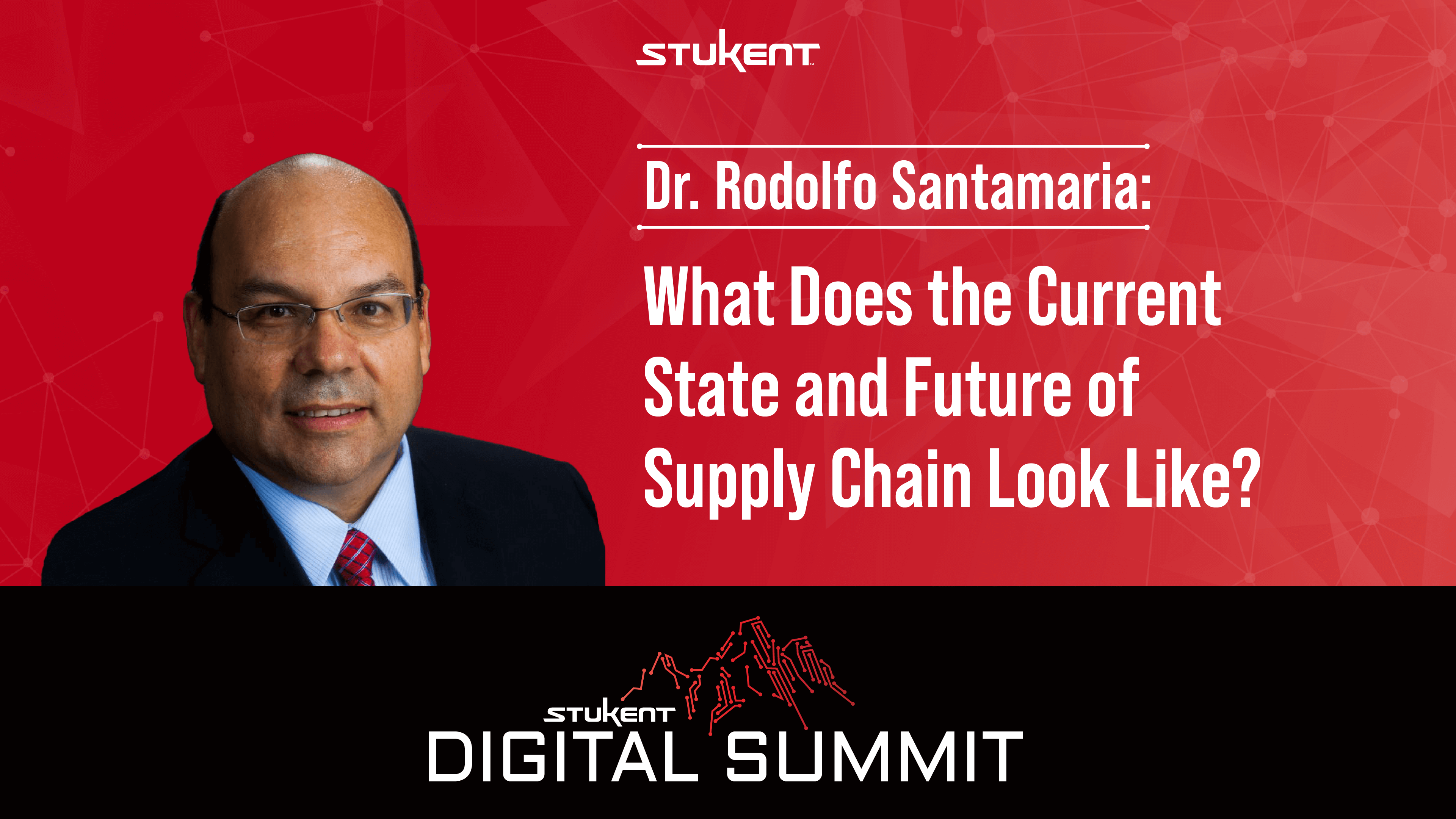In a time of new innovations, the supply chain industry is undergoing a profound transformation. Every facet of the industry is evolving quickly, from how products are sourced to how they reach consumers. Dr. Rodolfo Santamaria has lived through these changes during his 35 years of experience leading business transformations, strategy development, operations management, IT, and supply chain.
In his Stukent® Digital Summit: Supply Chain session, Rodolfo highlights the challenges supply chain specialists face today and what trends will shape the industry’s future. Read on for a recap of his insights!
Global Supply Chains and Their Complexity
A global supply chain is a network of organizations, people, activities, information, and resources that move a product or service from conception to the end user. It includes all the steps involved in manufacturing and delivering a product or service when those steps take place in more than one country.
Global supply chains have become increasingly complex and interconnected. This is due to several factors, including:
- The rise of globalization: The global economy has become increasingly interconnected, which has led to more businesses operating in multiple countries.
- The growth of e-commerce: E-commerce has made it possible for businesses to sell their products to customers worldwide.
- The development of new technologies: New technologies, such as big data and artificial intelligence, are being used to improve the efficiency and visibility of global supply chains.
Because of these new factors, Rodolfo said logistics and transportation are two of the most important aspects of any global supply chain. Efficient logistics and transportation are essential for businesses to operate effectively in the global economy. They help to reduce costs, improve customer service, and increase profits.
The Challenges of Global Supply Chain Management
Rodolfo recalled having many emotional challenges in his supply chain role: “I remember at some points I was going to my boss with bad news every day,” he said.
He shared an experience where he dealt with an earthquake. Hear his story in the clip below:
Rodolfo identified three challenges that supply chain managers face: volatility, complexity, and risk. Global supply chains are subject to several factors that can cause volatility, such as political instability, natural disasters, and economic crises. Due to the number of different organizations and individuals involved and the different cultures and regulations, supply chains can be complex to manage. Finally, he shared that risks such as supply disruptions, quality problems, and security threats pose challenges for supply chain professionals.
Rodolfo shared his leadership philosophy: Present problems with solutions. This approach not only aids in problem-solving but also demonstrates a proactive attitude. He showcased an example of information security and communication within supply chains, demonstrating the importance of adapting and finding ways to manage complex situations effectively.
The Future of Supply Chains
Today’s business landscape is markedly different from what it used to be. The rise of e-commerce, often called digital commerce, has reshaped how companies operate. The convenience of next-day delivery has become an expectation, prompting leaders to rethink their supply chain strategies. Rodolfo highlighted the prominent players in this arena, such as Amazon, Walmart, and companies in Asia, all of which are setting the standard for efficient and reliable delivery.
E-commerce will continue to grow in the coming years, putting even more pressure on global supply chains to be efficient and reliable. Luckily, new technology is helping with this stress. Supply chain specialists can use AI and robotics to automate tasks in the global supply chain — such as picking and packing orders — to contribute to efficiency gains and cost savings.
Rodolfo’s pursuit of innovation led him to explore technology’s impact on supply chain functions. He shared his journey of earning certifications in IoT, blockchain, and cybersecurity from MIT. Watch this clip for more details:
Sustainability has also emerged as a critical consideration in today’s supply chains.
“Businesses are increasingly under pressure to operate in a sustainable way,” Rodolfo said. “This is likely to lead to changes in global supply chains, such as a move toward renewable energy and more efficient transportation methods.”
Drawing from his background in green energy, Rodolfo discussed the importance of reducing carbon footprints and minimizing costs through efficient practices. By collaborating with partners, he advocated for a sustainability-driven mindset that aligns with responsible business practices.
He also discussed how emerging technologies, such as blockchain and 3D printing, have immense potential to drive change. While these technologies may seem daunting, he stressed the importance of embracing innovation despite its challenges.
Big data and analytics allow specialists to improve the visibility of supply chains and make better decisions about how to move goods around the world. For example, a study by the Aberdeen Group found that companies that use big data and analytics to improve their supply chains can achieve a 10% reduction in costs and a 5% increase in sales.
New transportation technologies, such as self-driving vehicles and drones, are being developed to make transportation more efficient and sustainable. These technologies make it possible to transport goods more quickly and efficiently, leading to lower costs and improved customer service. He also highlighted how third-party logistics providers (3PLs) are becoming increasingly popular as businesses outsource their logistics operations to experts, which frees up their resources to focus on their core competencies.
The Growth of the Supply Chain Industry
According to the U.S. Bureau of Labor Statistics, logistics and supply chain manager employment is projected to grow 7% from 2020 to 2030. On average, about 79,400 openings for logistics and supply chain managers are projected each year.
“The demand for skilled supply chain workers is expected to grow faster than the demand for unskilled workers,” Rodolfo said. “This is because businesses are increasingly looking for workers with specialized skills in areas such as data analytics, logistics, and supply chain management.”
The increasing globalization of trade, the growth of e-commerce, and the development of new technologies drives this growth. Rodolfo also emphasized an increasing shortage of skilled supply chain workers in many countries, caused by factors such as the retirement of baby boomers, the lack of educational programs in supply chain management, and businesses needing to invest in employee training.
According to a report by the World Economic Forum, the wages for supply chain workers are expected to grow faster than the average wage for all occupations. This is because the demand for skilled supply chain workers is outpacing the supply. The average annual wage for logistics and supply chain managers was $108,530 in May 2020. This is about 25% higher than the average annual wage for all occupations.
Supply chains are at a pivotal juncture with the rise of e-commerce, sustainability concerns, and the integration of cutting-edge technologies like AI and blockchain. Rodolfo’s emphasis on proactive problem-solving and the demand for skilled professionals reflects the industry’s dynamic future, where adaptability and innovation will be the guiding principles.
Stukent’s “Logistics & Transportation Management” courseware gives students a practical look into the logic and flow of a supply chain. It prepares students to identify tactical and transactional strategies, think strategically about supply chain design and how it impacts risk mitigation, and evaluate the end-to-end logistics plan for an organization.
Stukent Digital Summit: Supply Chain was held online on August 18, 2023. If you want to see Stukent’s upcoming events, visit the Events page on our website.
Stukent is here to help educators help students help the world. To learn more about our first-in-the-world Simternships™ and courseware, or to get FREE instructor access to our resources, visit our website.






